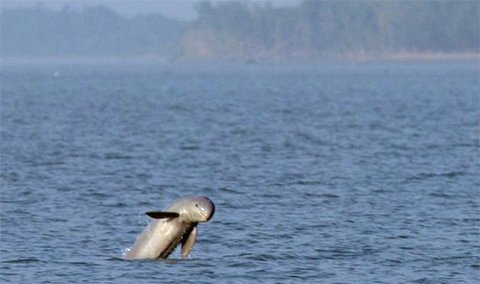Asian Dolphin Less Rare Than Thought.
 Recent surveys estimated that Bangladesh’s coast is home to nearly 6,000 Irrawaddy dolphins, several orders of magnitude more than any other population.
Recent surveys estimated that Bangladesh’s coast is home to nearly 6,000 Irrawaddy dolphins, several orders of magnitude more than any other population.Dolphin and porpoise species that have adapted to rivers and deltas around the world have long been considered some of the most vulnerable of marine mammals because of their restricted habitats. In 2007, the baiji, a river dolphin that thrived in the Yangtze River for 20 million years in today’s China, was said by experts to have been driven to extinction by a mix of impacts from the nearly half billion people now living in that watershed. The vaquita, a porpoise living in brackish waters where the Colorado River empties into the Gulf of California, is critically endangered, biologists say, depleted by fishing nets and the disruptions in the great river’s flow in the 20th century from dam construction.
But in the great weaving of mangrove-fringed islets and channels that make up the sprawling coast of Bangladesh, biologists have found a thriving population of another species that marine mammal experts had also thought depleted — the Irrawaddy dolphin. After methodical surveys, biologists from the Wildlife Conservation Society and Chittagong University in Bangladesh estimate that the region is home to 6,000 of the dolphins, by far the largest known population.
Little research had been conducted on marine mammals in the area until now, the wildlife group said. The International Union for Conservation of Nature has listed the species as vulnerable. The new research, published this week in two conservation journals, is reassuring, but the scientists who conducted the surveys warn of growing threats to the species, including risks from entanglement in fishing nets and changes in water flows from damming of the river (as with the Mexican porpoise).
“This discovery gives us great hope that there is a future for Irrawaddy dolphins,” Brian D. Smith of the conservation society, the study’s lead author, said in a statement. “Bangladesh clearly serves as an important sanctuary for Irrawaddy dolphins, and conservation in this region should be a top priority.”
As I’ve written here before, it may well be that the rarest thing in nature these days is abundance. So it’s worth celebrating this survey in Bangladesh. But it’s also worth having another look at the departed baiji, as a reminder of what can be lost when human activities overwhelm an ecosystem:
 The Yangtze River dolphin, or baji, is presumed extinct by marine mammal experts.
The Yangtze River dolphin, or baji, is presumed extinct by marine mammal experts.Original Source : http://dotearth.blogs.nytimes.com/2009/03/31/asian-dolphin-less-rare-than-thought/




